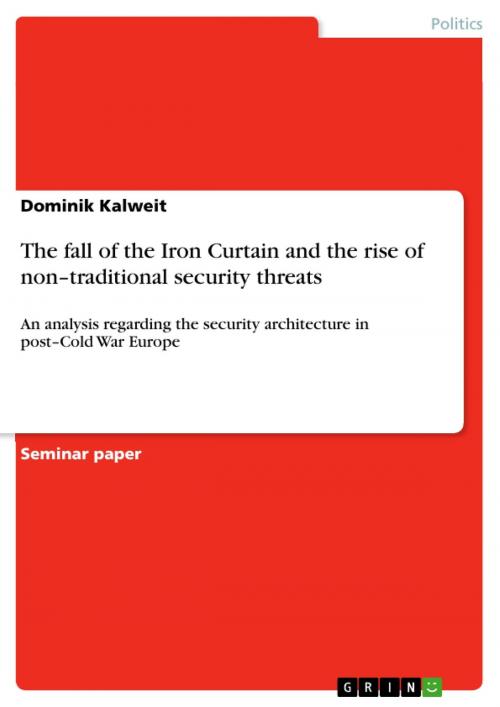The fall of the Iron Curtain and the rise of non-traditional security threats
An analysis regarding the security architecture in post-Cold War Europe
Nonfiction, Social & Cultural Studies, Political Science| Author: | Dominik Kalweit | ISBN: | 9783638885140 |
| Publisher: | GRIN Publishing | Publication: | January 4, 2008 |
| Imprint: | GRIN Publishing | Language: | English |
| Author: | Dominik Kalweit |
| ISBN: | 9783638885140 |
| Publisher: | GRIN Publishing |
| Publication: | January 4, 2008 |
| Imprint: | GRIN Publishing |
| Language: | English |
Seminar paper from the year 2005 in the subject Politics - International Politics - Region: Western Europe, grade: B+, University of Malta (University of Malta - Faculty of Arts / International Relations), course: European Security and Defence II (IRL2095), 24 entries in the bibliography, language: English, abstract: The socio - political developments of the outgoing 1980s and beginning 1990s to the greatest extent in Europe initiated the rise of a new era, impacting various political, societal and economic levels drastically throughout the world. With the fall of the Iron Curtain, i.e. the drowning of the Union of Soviet Socialist Republics (USSR) and its split into (semi-) independent states , the breakdown of East Germany (GDR) and its unification with the Federal Republic of Germany (FRG) , and the turn up of the United States of America (USA) as the only liable superpower, the final act of the forty years lasting Cold War era found its cumulating closure. The paradigm of the West versus the East, of democracy versus communism was determined, and new patterns had and - since this redefinition appears to be an ongoing process - have to be rethought. In terms of security, the school of the political scientist Barry Buzan presented a structural cluster for the understanding of new evolving threats, resulting from the dissolution of the bipolarity with Russia and USA as having been oppositional poles of more or less equal strength. Apart from the military - related aspects that have dominated the thinking of conflict research throughout the period of the Cold War, this approach includes the means of politics, society, economy and environment as inter-relating and equally impacting issues of high importance for the analysis of security politika. This analysis strives to present the main issues which characterise the transformation of the European security system from the 1990s until today. Hereby, conceptual approaches regarding a theoretical framework of the newly either emerged or recognised threats are related to the actual agenda of the most important players, to say states and institutions, the like, without loosing the perspective for important non-official political actors such as non governmental organisations (NGOs) or (mega-) terrorists (to mention a positive and negative example), as well as economic influences. A description and explanation of the present European security architecture hereby entails the aspects of the phenomenons of globalisation and the idea of a global governance.
Seminar paper from the year 2005 in the subject Politics - International Politics - Region: Western Europe, grade: B+, University of Malta (University of Malta - Faculty of Arts / International Relations), course: European Security and Defence II (IRL2095), 24 entries in the bibliography, language: English, abstract: The socio - political developments of the outgoing 1980s and beginning 1990s to the greatest extent in Europe initiated the rise of a new era, impacting various political, societal and economic levels drastically throughout the world. With the fall of the Iron Curtain, i.e. the drowning of the Union of Soviet Socialist Republics (USSR) and its split into (semi-) independent states , the breakdown of East Germany (GDR) and its unification with the Federal Republic of Germany (FRG) , and the turn up of the United States of America (USA) as the only liable superpower, the final act of the forty years lasting Cold War era found its cumulating closure. The paradigm of the West versus the East, of democracy versus communism was determined, and new patterns had and - since this redefinition appears to be an ongoing process - have to be rethought. In terms of security, the school of the political scientist Barry Buzan presented a structural cluster for the understanding of new evolving threats, resulting from the dissolution of the bipolarity with Russia and USA as having been oppositional poles of more or less equal strength. Apart from the military - related aspects that have dominated the thinking of conflict research throughout the period of the Cold War, this approach includes the means of politics, society, economy and environment as inter-relating and equally impacting issues of high importance for the analysis of security politika. This analysis strives to present the main issues which characterise the transformation of the European security system from the 1990s until today. Hereby, conceptual approaches regarding a theoretical framework of the newly either emerged or recognised threats are related to the actual agenda of the most important players, to say states and institutions, the like, without loosing the perspective for important non-official political actors such as non governmental organisations (NGOs) or (mega-) terrorists (to mention a positive and negative example), as well as economic influences. A description and explanation of the present European security architecture hereby entails the aspects of the phenomenons of globalisation and the idea of a global governance.















